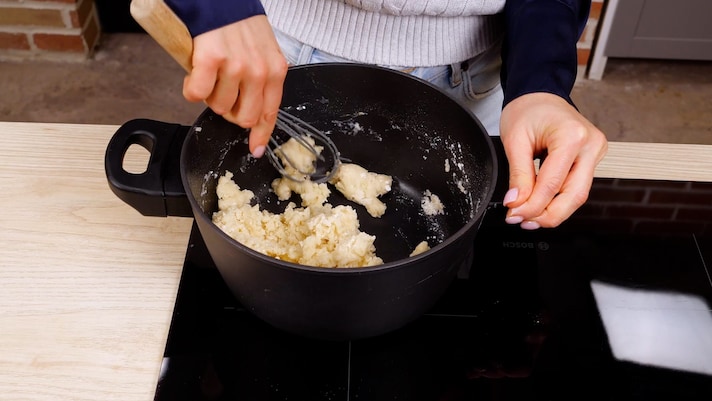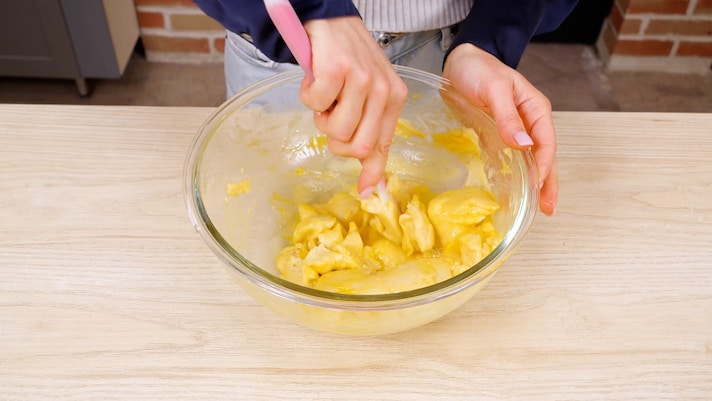Easy Homemade Churros Recipe

Churros (pronounced as CHOOR-ohs) are cylindrical and elongated desserts typical of Madrid and, in general, of Spanish and Latin American cuisine. The name, in English, can be translated as "fried dough sticks": they are crispy sticks on the outside and slightly spongy on the inside, prepared with a batter of flour, water and salt, then fried in boiling oil and covered in sugar while still hot.
Their particular shape is traditionally given by the churrera, a sort of metal pastry syringe through which the dough is squeezed directly into the pan with the oil. Of course, if you don't have the appropriate tool, you can just replace it with a normal piping bag with a star-shaped nozzle; in our version, eggs and butter have also been added, for an even more delicious and soft-hearted result.
Nowadays, they are usually enjoyed on Sundays for breakfast or as a dessert on festive occasions: they are also perfect for a tasty snack or to offer to children for a birthday party.
What Are Churros? Origins and History
Churros are believed to have originated in Spain, with some attributing their creation to Spanish shepherds who lived in the Iberian mountains. The treat likely evolved from a simple fried dough recipe brought by Portuguese explorers to the Americas. Over time, churros became popular in Latin America, with variations such as filling them with dulce de leche or chocolate. Today, churros are enjoyed worldwide, often served at breakfast, festivals, or as street food, gaining international recognition for their crispy exterior and soft interior, frequently dusted with sugar and cinnamon.
Pro Tips for The Best Homemade Churros
- Opt for all-purpose flour for the best texture. It creates a dough that's sturdy enough to hold shape while being light and airy inside.
- Fry the churros at a temperature of 180°C (350°F). If the oil is too cold, the churros will absorb excess oil and become soggy. If it's too hot, they may cook too quickly on the outside without fully cooking inside.
- When mixing the dough, be careful not to overwork it. Stir it just enough to combine the ingredients—this helps to achieve a tender inside and crispy exterior.
- For perfectly shaped churros, pipe the dough directly into the hot oil. Use a star-shaped nozzle to get the traditional ridged shape that helps the churros become crispier.
- Don't overcrowd the frying pan. Fry the churros in small batches to ensure even cooking and prevent the oil temperature from dropping too much.
- Churros are best served fresh and hot. After frying, coat them in a sugar-cinnamon mixture immediately for maximum flavor.
- While traditional churros are served plain with sugar, feel free to experiment by filling them with chocolate, dulce de leche, or custard for a fun twist!
Are Churros Mexican or Spanish?
Churros originally come from Spain, where they were created by Spanish shepherds and later introduced to the Americas. In Spain, churros are typically thin, straight sticks, often enjoyed with hot chocolate for dipping. In contrast, the Mexican version is thicker, frequently filled with chocolate or dulce de leche, and coated with a generous layer of cinnamon sugar, making it sweeter and more indulgent.
Are Churros and Doughnuts the Same?
Churros and doughnuts do not use the same type of dough. While both are fried pastries, churro dough is typically made from water, flour, salt, and sometimes a little sugar, which gives it a denser, chewier texture. In contrast, doughnut dough often includes yeast or baking powder, along with eggs, milk, and butter, resulting in a lighter, fluffier texture. Doughnuts are also often leavened, whereas churros rely on the heat of the oil to puff up, creating a crispy exterior and a soft interior.
What Do Churros Taste Like?
Churros have a crispy exterior and a soft, tender interior. They are often coated in a mixture of cinnamon and sugar, giving them a sweet and slightly spiced flavor. The dough itself is mildly savory, with a rich, comforting taste from the frying process, while the outer coating adds a warm, sugary sweetness that balances perfectly with the dough.
What If I Don't Have a Piping Bag?
If you don't have a piping bag, you can use a zip-top plastic bag as a substitute. Simply fill the bag with the churro dough, seal it, and cut off a small corner to pipe the dough. Alternatively, you can use a wide-mouthed glass or jar to hold the dough, then carefully spoon it into the oil using a spoon or a makeshift piping tool like a plastic squeeze bottle.
Help! My Churros Are Raw Inside!
Churros might be raw inside if the oil is not hot enough when frying. If the oil temperature is too low, the churros will cook too slowly, causing the outside to brown before the inside fully cooks. To avoid this, make sure the oil is at the proper temperature (around 180°C or 350°F) to ensure even cooking and a crispy exterior with a fully cooked interior.
Why Are My Churros Not Crispy?
Churros may not be crispy if the oil temperature is too low or if they are not fried long enough. If the oil isn’t hot enough, the churros will absorb too much oil and become greasy instead of crisp. Additionally, if they are taken out of the oil too early, they won't have enough time to develop a crunchy exterior.
How Can I Serve My Churros?
Delicious plain or sprinkled with a mixture of sugar and cinnamon, they can be dipped in a bowl of cocoa and hazelnut cream – as in our case – but also filled with chocolate, jams and marmalades or served, Argentine fashion, with dulce de leche, a voluptuous cream made from milk and sugar, similar to mou sauce.
Can I Make Them a Bit Healthier and Lighter?
For a lighter but equally delicious version, you can bake the churros in the oven: preheat the appliance to 360F (180°C), shape the loaves with a piping bag directly onto a baking tray lined with baking paper and bake them for about 20 minutes, until golden brown. You can also use an air fryer. Fry them at 375˚F for 10 to 12 minutes.
Can I Make Churros Ahead of Time?
Churros are best enjoyed fresh, but you can make them ahead of time by frying them and then storing them in an airtight container at room temperature for up to a day.
To re-crisp them, simply heat them in the oven for a few minutes. However, they may lose some of their original texture and freshness if stored for too long. It's always ideal to enjoy churros right after frying for the best taste and crunch.
Can I Freeze Homemade Churros?
Yes, churros can be frozen. After frying, let them cool completely, then place them in an airtight container or freezer bag. They can be stored in the freezer for up to 2 months.
To reheat, bake them in the oven at a low temperature or fry them briefly to restore their crispiness. However, freezing may slightly affect their texture, so they’re best enjoyed fresh.
Some Churros Variations to Experiment With!
How to Store Homemade Churros
Once ready, churros are great to eat right away, hot and fragrant. The batter can be stored in the fridge, better if already in the piping bag, for 1 day maximum.
Ingredients
How to Make Homemade Churros

To prepare the churros, start by pouring the water in a large pot, preferably ceramic or steel.
To prepare the churros, start by pouring the water in a large pot, preferably ceramic or steel.

Add the salt and the pieces of butter, then mix and bring the water to the boil.
Add the salt and the pieces of butter, then mix and bring the water to the boil.

When the butter and salt have melted and the water is boiling, add the all-purpose flour all at once.
When the butter and salt have melted and the water is boiling, add the all-purpose flour all at once.

Start mixing slowly, with the help of a whisk, so that the flour can absorb the liquids without forming lumps.
Start mixing slowly, with the help of a whisk, so that the flour can absorb the liquids without forming lumps.

Proceed to work the ingredients to make them homogeneous: it will take about 3 minutes. Then take the spatula and mix everything well again, pressing the mixture several times on the bottom of the pan so as to finish cooking and give it the right consistency.
Proceed to work the ingredients to make them homogeneous: it will take about 3 minutes. Then take the spatula and mix everything well again, pressing the mixture several times on the bottom of the pan so as to finish cooking and give it the right consistency.

In the end, you should obtain a smooth and compact dough, to be immediately transferred into a large glass or ceramic bowl, preferably cold.
In the end, you should obtain a smooth and compact dough, to be immediately transferred into a large glass or ceramic bowl, preferably cold.

To make it cool down faster, spread it along the edges of the bowl.
To make it cool down faster, spread it along the edges of the bowl.

Once lukewarm, but not cold, continue cracking one egg at a time and incorporating it with the spatula.
Once lukewarm, but not cold, continue cracking one egg at a time and incorporating it with the spatula.

Initially the mixture will be loose and "in chunks", but continue to work it vigorously to make it homogeneous. Only when the first egg is completely absorbed, proceed with the second and then the third.
Initially the mixture will be loose and "in chunks", but continue to work it vigorously to make it homogeneous. Only when the first egg is completely absorbed, proceed with the second and then the third.

In the end you will get a smooth, thick and full-bodied dough.
In the end you will get a smooth, thick and full-bodied dough.

Transfer it immediately into a piping bag with a star-shaped nozzle with a diameter of 1.5-2cm, depending on the size you want your churros to be. Place the dough in the refrigerator to rest for 30 minutes.
Transfer it immediately into a piping bag with a star-shaped nozzle with a diameter of 1.5-2cm, depending on the size you want your churros to be. Place the dough in the refrigerator to rest for 30 minutes.

Once the necessary time has elapsed, pour plenty of peanut oil into a large pan, bring it to a temperature of 340F (170°C) and start creating the churros, squeezing the dough directly into the oil and cutting into strips of about 10cm in length with the help of a knife or kitchen scissors.
Once the necessary time has elapsed, pour plenty of peanut oil into a large pan, bring it to a temperature of 340F (170°C) and start creating the churros, squeezing the dough directly into the oil and cutting into strips of about 10cm in length with the help of a knife or kitchen scissors.

Fry the churros, turning them often so that they are always immersed in the oil, until they are puffed up and golden. Drain them and transfer them onto a sheet of absorbent paper or straw paper.
Fry the churros, turning them often so that they are always immersed in the oil, until they are puffed up and golden. Drain them and transfer them onto a sheet of absorbent paper or straw paper.

Immediately pass them in granulated sugar while they are still hot, as as to cover them perfectly.
Immediately pass them in granulated sugar while they are still hot, as as to cover them perfectly.

The churros are ready. Enjoy!
The churros are ready. Enjoy!
;Resize,width=767;)
;Resize,width=712;)
;Resize,width=712;)

